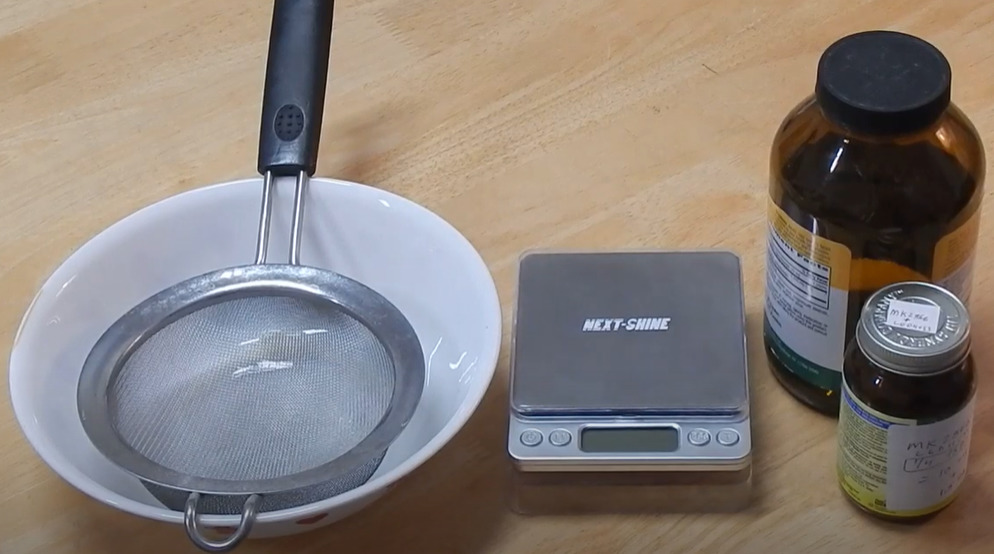If you bought yourself some SARM powder and don’t know what to do with it, you’re at the right place.
I was just in your position a few years ago, but now, with a lot of experience behind my back, I’m ready to give something back to the community.

Today, I’ll be discussing the consumption of powder SARMs and the best way to convert them to a liquid.
I’ll also explain why someone would want to do that in the first place.
Table of Contents
ToggleHow to take the SARM powder
Taking the powder is the least of your worries, many people like to just put it on their tongue and chase it down with a glass or two of water. I should also note that when consuming the powder, you feel the awful taste a lot more when compared to the liquid.
The real problem stems in measuring the powder in the first place. If you’re taking something like 2,5mgs of Ligandrol, just as I did in my log, you’ll have a really hard time measuring enough of the powder.
For the sake of reference, 2,5mgs is barely visible to the naked eye.
Unless you want to spend literally hundreds of dollars on a professional, high-precision weight scale, you will not be able to gauge 2,5mgs reliably. Don’t even attempt to do it ‘by eye’ or with a 10$ scale from Amazon or eBay, as even a 1mg lapse could lead to increased side effects to be experienced. And believe me, you would be more than 1mg off if you did it in these ways.
So, you basically got two choices on your hands:
- Spend hundreds of dollars on a professional measuring tool
- Turn your SARM powder into a liquid solution, thereby alleviating some of the bad taste and making it easier to measure out the correct dosage.
This article will focus upon option two; if you have the money to go for option one, I still encourage you to read on, as the science behind it is very interesting and who knows, it might come in handy someday.
Converting SARMs powder to Liquid
Before we start, I want to remind everyone that there is nothing illegal in turning your research chemicals from one state to another, so there is nothing to worry about.
I’ll make a list of utensils needed so that you can preemptively know what needs to be bought and what can be found in the confines of your kitchen.
- A kettle (In the lab, I usually use a magnetic hotplate stirrer, but a kettle will do just fine)
- A small 10$ scale of eBay or Amazon (that can measure in mgs)
- A shot glass (any will do)
- A small bowl
- A small piece of foil
- A dropper, any eye dropper is fine
- SARMs Powder (obviously)
- DMSO (Dimethyl sulfoxide) – This is going to be our solvent, it’s easy to buy and it increases the bioavailability of SARMs, you can also use Everclear if you’re from the US, it has 95% alcohol in it
- PEG 300 (Don’t buy any other derivatives, PEG 400 and PEG 500 make the solution too thick)
- Vegetable glycerin – It will thicken the solution a bit and make it taste better, really easy to buy
For the purposes of this experiment, we’ll be creating 30mls of Cardarine and each ml will contain 25mgs of the product.
This means that you’ll need at least 750mgs of Cardarine powder to get this experiment started.
A note of caution, the liquid we make will still be bitter to the tongue, the only way to make it taste better is to use a catalyst, but we’re not going to be doing that, since it requires advanced chemistry. You’ll just have to suck it up and get used to the bad taste or read my guide on taking liquid SARMs to learn a few tips and tricks.
Once you get the hang of things, you can also do bigger batches, I sometimes do 2 or 3 grams at a time, but for now, let’s stick to the basics.
Step by step
Here is the step by step process of turning 750mgs of Cardarine powder into 30mls of liquid Cardarine.
- Boil a bit of water inside of your kettle
- When the water is boiled, put it inside of your small bowl, fill about 30% of the bowl with water. You can now remove the kettle from your ‘research grounds’, as it’s no longer needed.
- The next step is measuring out your powder. Put the piece of foil on your scale, zero it out (reset the scale back to zero, so that it doesn’t measure the foil itself). Measure out 750mgs of powder by putting enough of it on the scale. Don’t be surprised by the fact that it won’t be much powder.
- Now we’re going to measure out our solvent, DMSO. Take your eye dropper and measure out 10% of the total (end) solution, which is 3ml in our case. Put the solvent into your shot glass and now put the shot glass inside of your bowl, where your boiled water is located.
- Now that the solvent has warmed up nicely in your shot glass, carefully add the powder to the solvent and start mixing until all the lumps are gone. Put the new solution back into the warm water.
- Next up is the PEG 300 we’ve bought. Add 60% of the total (end) solution to your mix, which means that you have to measure out 18ml of PEG 300 and add it to your mix. Stir once more for 10 to 20 seconds. The solution should be clear now, without any lumps or bits left.
- The last liquid we use is vegetable glycerin. Now that we have 70% of the solution ready, it’s time to add the last 30% into the shot glass, for a total of 30ml or 100%. That’s going to be 9ml of vegetable glycerin. Stir once again for 10 to 15 seconds and you’re done!
- Store your liquid at room temperature, preferably in a vial that you can seal. Use your eye dropper to measure out your solution.
If you’re confused with the math used in this tutorial, I’ll reiterate it once more to make it easier for you.
So, we need 30mls of solution in total and for that we use four substances; Cardarine powder, DMSO, PEG 300 and vegetable glycerin.
3ml of DMSO + 18ml of PEG 300 + 9ml of vegetable glycerin + 750mgs of Cardarine Powder = 30mls of liquid Cardarine.
Conclusion
I hope that things are a bit easier on you now, if you still have any questions or concerns, please don’t hesitate to post a comment. I’ll do my best to answer any inquires as soon as I have the time.
That’s it, you’re now ready to dip your feet into the wonderful field of chemistry and most importantly, turn your SARM powders into liquids!

